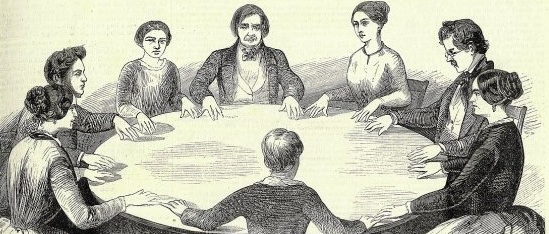Victorian Spiritualism
Posted on 4th September 2021
People have always had the capacity in whatever age they live to believe that human understanding is the fount of all knowledge. Yet for most of human existence a belief in an immaterial God, or Gods, has been almost universal. God existed; it was a fact. Yet now we live in a secular age when a belief in God is often frowned upon or viewed as being almost dysfunctional. But then we have often confused a belief in God with an adherence to religious texts written by man; that some use these texts as a justification for an endless stream of invective and acts of violence cloaking their own political agenda in the legitimacy of the Almighty creates even greater abhorrence to the notion of faith. Indeed, it could be said that violence has been the greatest physical and material manifestation of religion down the centuries but then we should not be surprised at this for religion is after all a Death Cult, but it is in this religious death that comes eternal life. Where however is the evidence for life after death?
Death comes to us all and is often referred to as the great leveller, so the fact that we seek knowledge of an afterlife is perhaps understandable. Some choose to do this through the conduit of religion and the intercession of a priest whilst others prefer a more direct approach. Many deny the existence of an afterlife at all, but then given we have no knowledge of death an atheist can say this with no more conviction than a person of faith can claim the opposite, and it is much easier to believe in God and an afterlife than it is for a sentient being to comprehend non-existence.
The fact that it might be possible to witness the physical manifestation of a post-death existence was greatly influenced by the work of the Swedish born Emanuel Swedenborg. He was a scientist and engineer who came to religious prominence late in life and was 53 years of age before he published his fist book on the subject. He claimed to have had a spiritual awakening and had been spoken to directly by God who had told him to write the New Church Doctrine. He’d had his first vision on 6 April 1744, and since then had been in regular contact with the next world being able to visit Heaven and Hell at will. His writings and apparent psychic encounters influenced a great many philosophers and academics. They also formed the basis of the spiritualist movement to come.
Spiritualism reached its apex during the Victorian period and could be said to have begun with two young girls in Hydesville, New York.
Margaret and Kate Fox, aged 15 and 12 respectively, lived in a house that was already believed to be haunted because it was said a man had been murdered and buried there, and in 1904 an unidentified skeleton was indeed discovered in the cellar.
They claimed to have heard and been frightened by frequent loud raps and the sound of furniture being moved. These noises were also heard by their mother who unable to explain them invited her neighbours to visit and witness events for themselves. The occurrences of strange noises and mysterious sounds only appeared to happen when the girls were present. It was soon thought that the girls had an unexplained connection with the afterlife and the spirit world. Kate reinforced this view by claiming to be in contact with a familiar known as Splitfoot, an old term for the devil.
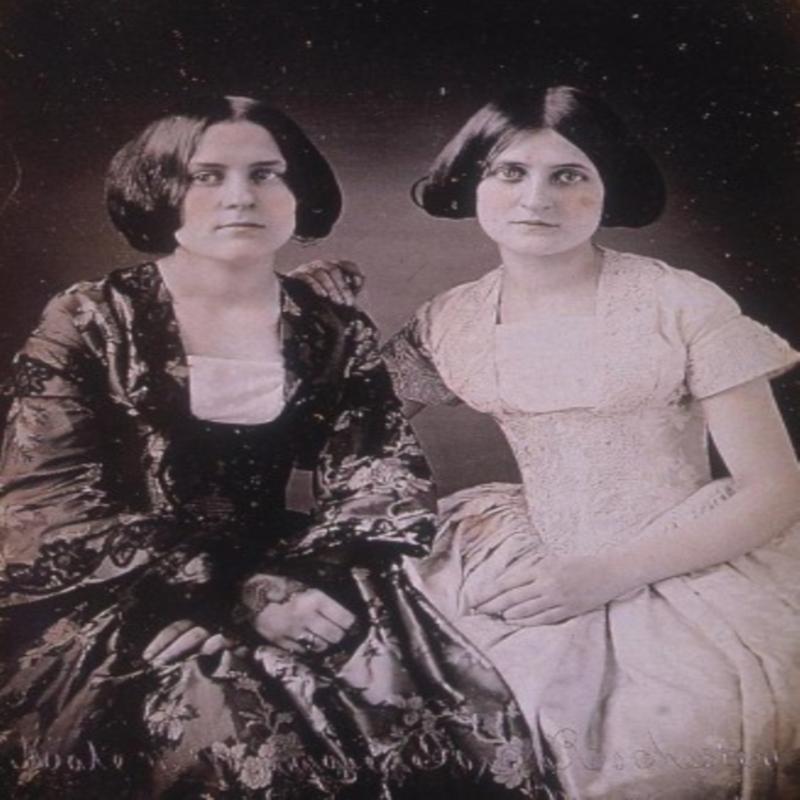
By 1850, the girls managed by their older sister, Leah, were holding regular séances. Their fame soon began to spread and their séances were attended by such eminent Americans as the author James Fennimore Cooper, the journalist Horace Greeley, and the abolitionist William Lloyd Garrison.
The popularity of spiritualism as it became known soon spread and quickly made its way across the Atlantic. Mediums began to crop up everywhere the most famous of whom was a Russian émigré Helena Petrovna, or Madame Blavatsky. She had married aged 18 to Nikifor Blavatsky but it was a sham marriage designed to free her from the restraints of home. From then on, she travelled widely to Egypt, India, and Tibet. She had always had a deep interest in religion and whilst in India she came under the influence of various gurus and yogis.
In the United States Spiritualism had taken hold during and following the end of the American Civil War. Indeed, when President Abraham Lincoln’s young son William died on 20 February 1862, his wife Mary held regular séances in the White House. Lincoln himself only attended once merely to placate his wife and had left early clearly disgruntled by what he had witnessed.
In 1872, Madame Blavatsky arrived in New York saying that she had been sent to prove the phenomenon and the reality of spiritualism. It was in New York that she was to make her name as a medium and she soon became famous for her clairvoyant and telepathic powers. In September 1875, along with others, she founded the Theosophical Society which had at its heart a belief that it possessed a mystical insight into the nature of God and the soul of man. It taught that all religions have truth in their inner teachings but are corrupted by their external manifestations.
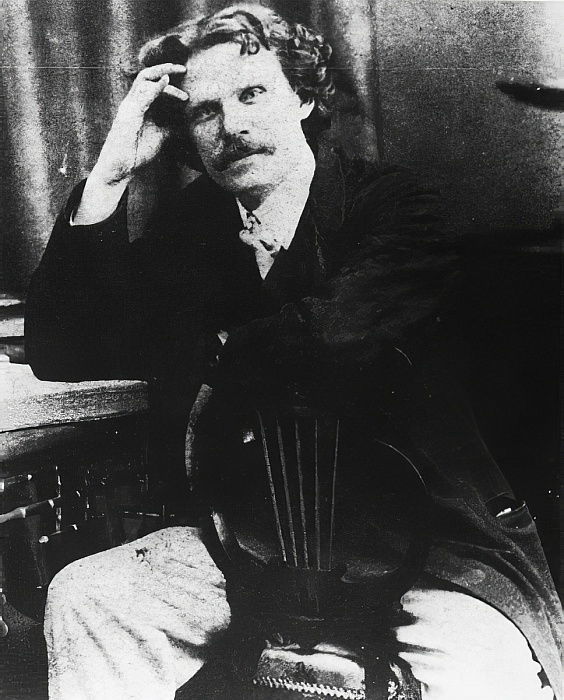
The most popular medium working in England during the Victorian period was the Scots born Daniel Dunglas Home.
His parents had moved the family to the United States in 1840 when he was aged 7, and it was in America that he first made his name as a medium claiming to have had visions and the ability to foresee the future. He had as a child predicted that his brother would drown whilst on the crossing to Greenland, which indeed he did.
He now claimed to have been sent by God to prove the existence of immortality and determined to spread the word he decided in 1855 to do so by returning to Britain.
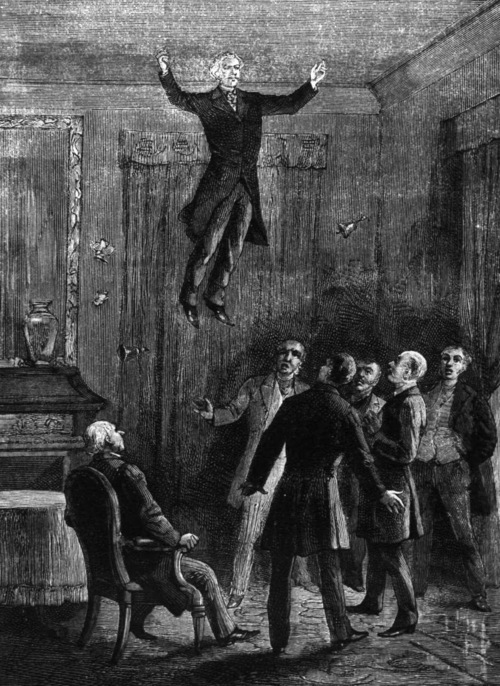
Home said that he wished to expose those frauds who, carried out their séances in near darkness and so insisted that his would be held in the brightest of light. His séances were also physical affairs, and he was most famous for being able to levitate himself out of one window and then back through the open window of an adjacent room. Those who witnessed him to do this insisted that there were no props.
Also popular around this time were the brothers Ira and William Davenport from Buffalo, New York. They followed in the wake of the Fox sisters and hearing of their success had decided to take to the road themselves. They claimed to have received supernatural powers from the spirit world and the most anticipated part of their seance or act was the so-called “spirit cabinet.” The two brothers would be tied to a bench inside a cabinet full of musical instruments, the door of the cabinet would then be closed and not long after the sound of the musical instruments being played could be heard coming from the cabinet. When the door of the cabinet was opened it revealed the brothers still tied to the bench as they had been when the door was closed. They claimed that the instruments had been played by spirits they had summoned from the other side specifically to do so.
In the 1860’s the brothers toured Britain and were a great success. While in England they were investigated by members of the Ghost Club, which had been formed in London in 1862 to investigate paranormal activity. Their report was never officially released but when magicians who knew how to tie a knot attended their séances and volunteered from among the audience to tie the brothers to the bench no musical instruments were played, the brothers obviously being unable to release themselves. Despite the “spirit cabinet” being exposed as nothing more than a trick the brothers remained popular – people just enjoyed the show.
Despite the popularity of Madame Blavatsky, Daniel Dunglas Home, the Fox Sisters, the Davenports and many others no firm proof was ever provided that showed they had made contact with the dead. Indeed, one regular visitor to their séances described them as being little more than a series of foot-tapping creaking of doors, and knocking of tables. Likewise, the many reports of ghostly occurrences and paranormal phenomenon that were so common during the Victorian period were often disparaged at the time and have been largely discredited since. As have the many photographs taken. Advances in technology allow us now to undertake the most elaborate of hoaxes but back then in the early days of photography such tricks were crude in the extreme.
It is difficult to accurately assess why spiritualism became so popular during the Victorian period. After all, Victorian Britain was not a country renowned for self-doubt. Few people in Britain doubted the advantages of commerce and free trade, few people doubted the Empire and the Briton’s right to rule over other people, and few doubted the superiority of the British political system. It was however also a time of religious unease; a fire and brimstone evangelism had taken root displacing in part the mild meanderings and gentle counsels of the Church of England. The publication of Charles Darwin’s Origin of the Species in November 1859 had provided substance to those who now cast doubt upon the literal truth of the Bible.
If as many people believed science could resolve all of life’s problems then why, if life after death existed, could it not be proved? For some eminent Victorians spiritualism provided a challenge, either to prove the truth of Christian faith by confirming the existence of an eternal life, or to debunk the entire thing as a hoax.
To many middle-class Victorians however it was much simpler, it was entertainment. The rigid class structure of Victorian society meant that the popular Music Hall and bawdier elements of popular culture were strictly off-limits. This was particularly so for middle-class women who always made up a majority of any audience attending a séance. It was an opportunity for them to let their hair down.
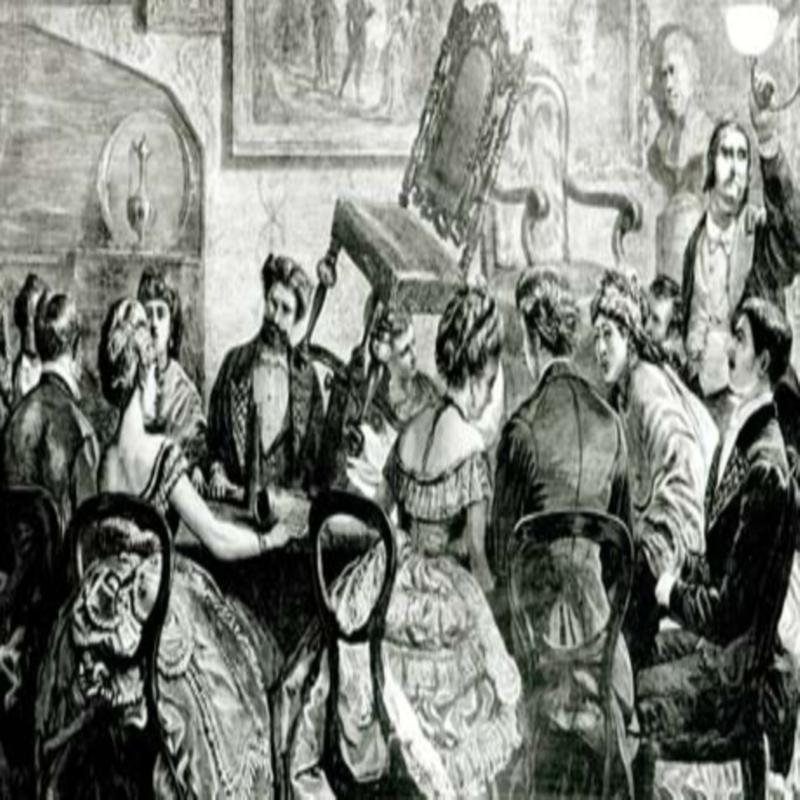
Seances were not necessarily the solemn affairs we might imagine but could often be quite frivolous in tone. Madame Blavatsky it was said would flounce around as if in a fog of cigarette smoke and would be indiscreet if not downright rude in her remarks. Some mediums encouraged their audience not only to hold hands and form a circle but also to sing and dance. People would shout out and heckle each other and sharp intakes of breath and audible gasps of astonishment were positively encouraged. In a séance the sexual and social barriers that existed between men and women were broken down and strangers would hug one another and exchange flirtatious glances and gentle caresses.
A favourite of any séance was the excretion of ectoplasm, a white gauze-like fabric that would most often appear from a medium’s mouth as if in an endless stream. Sometimes they would place it over their shoulders or drape it over the furniture. By the 1870’s many séances had become more like a visit to the theatre and conjuring tricks and acts of escapology had become commonplace.
Such antics appalled many of those who saw through the mockery of séances claiming to offer an insight into the mysteries of life after death. George Eliot, who was convinced that séances were nothing more than trickery and deceit, described Daniel Dunglas Home as being morally disgusting, and he was attacked elsewhere as being worthless in the sum of human knowledge “the spirits he has summoned,” it was said, “are as uniformly dull and prosaic, ignorant and uninteresting as he is himself.”
The poet Robert Browning wrote regularly to the newspapers to voice his disgust at the mediums who peddled their lies for money. This put him in direct opposition to his wife Elizabeth Barrett Browning who was a firm believer and led to many a row between the two.
None of the criticisms levelled at spiritualism did anything to dent its popularity and it always had as many eminent supporters as it did detractors. By the time of Queen Victoria’s death in 1901 the belief in spiritualism had begun to wane but séances remained popular. It was to see a huge revival however in the 1920’s following the end of the Great War.
As for the Fox sisters who were largely responsible for the popularity of spiritualism in the latter decades of the nineteenth century their fortunes were to come to an abrupt end. Margaret, who had since converted to Roman Catholicism, had begun to see her involvement in spiritualism as like dabbling in the occult. Both Margaret and Kate had also fallen out with their elder sister Leah who was drinking heavily, and they believed was also squandering their money.
In 1888, they were offered $1,500 by a sceptical journalist if they revealed what he referred to as their tricks. On 21 October, Margaret Fox, as her disgruntled sister Kate sat alongside her, revealed before an audience of 2,000 people in New York that the strange rapping noises so prevalent at their séances was no more than the manipulation of their muscles and joints:
“My sister Katie was the first to observe that by swishing her fingers she could produce certain noises with her knuckles and joints, and that the same effect could be made with the toes. Finding that we could make raps with our feet – first with one foot and then with both – we practiced until we could do this easily when the room was dark. Like most perplexing things when made clear it is astonishing how easily it is done.”
She then explained how practising control you could make the muscles click on demand and that was the trick: “A great many people when they heard the rapping thought the spirit was touching them. It’s pure imagination.”
She then went onto explain how it had begun all those years ago when they were still children. How having heard that the house they were living was supposed to be haunted they had done it just for some fun and to tease their mother.
“When we went to bed at night we used to tie an apple to a piece of string and move the string up and down, causing the apple to bump on the floor, or we would drop the apple on the floor, making a strange sound every time it would rebound. Mother listened to this for a time. She would not understand it and did not think of us being capable of tricks because we were so young.”
Margaret’s confession was to utterly destroy the reputation of the Fox sisters, though Kate who never forgave Margaret for her betrayal was to continue to hold séances for the rest of her life. They both died in poverty five years later within a few months of each other.
The confession of Margaret Fox did little to dent the popularity of spiritualism however which remained a source of popular entertainment for many and an article of faith for some.
Harry Houdini, the famous escapologist, who was to devote much of his time to exposing séances as being nothing but a series of magic tricks and was to offer a substantial reward to any medium who could prove there was life after death, used the exposure of the Fox sister’s and others as frauds as proof that it was trickery and nothing more. Sir Arthur Conan Doyle, a friend of Houdini’s before they fell out over the issue, and a firm believer in spiritualism merely said that it was only natural for a medium to influence the events of a séance.
Tagged as: Victorian
Share this post:





